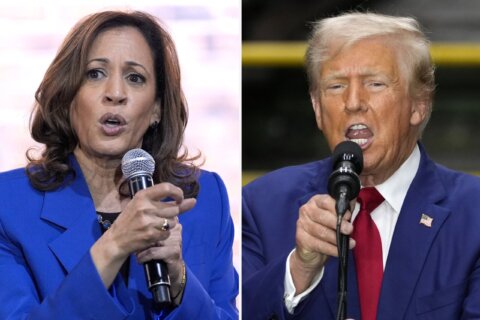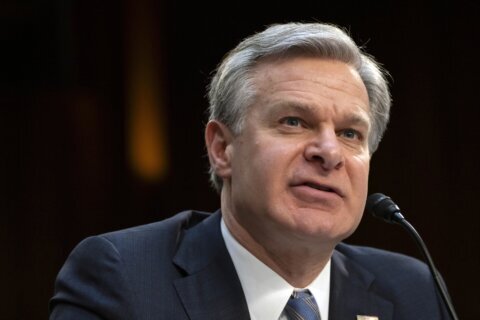WASHINGTON (AP) — The U.S. general election on Nov. 5 will decide the country’s direction, but it is far from a nationally administered contest. The 50 states and the District of Columbia run their own elections, and each does things a little differently.
Here’s a look at some notable variations in the 2024 election:
Maine and Nebraska allocate electoral votes by congressional district
To win the presidency outright, a candidate must receive at least 270 of the 538 votes in the Electoral College. In 48 states, the statewide winner gets all of that state’s electoral votes, and that’s also the case in the nation’s capital.
In Maine and Nebraska, the candidate who receives the most votes in each congressional district wins one electoral vote from that district. The candidate who wins the statewide vote receives another two.
In 2020, Democrat Joe Biden received three of Maine’s four electoral votes because he won the popular vote in the state and its 1st Congressional District. Republican Donald Trump received one electoral vote from the 2nd Congressional District. Trump won four of Nebraska’s five votes for winning the popular vote in the state as well as its 1st and 3rd Congressional Districts; Biden received one electoral vote for winning the 2nd Congressional District.
Alaska and Maine use ranked choice voting
In ranked choice voting, voters rank candidates for an office in order of preference on the ballot. If no candidate is the first choice for more than 50% of voters, the candidate with the fewest votes is eliminated. Voters who chose that candidate as their top pick have their votes redistributed to their next choice. This continues, with the candidate with the fewest votes getting eliminated, until someone emerges with a majority of votes.
Maine uses ranked choice voting in state-level primaries and for federal offices in the general election. That means Maine voters can rank presidential, Senate and House candidates on ballots that include the Democrat and the Republican who advanced out of their respective party primaries, plus third-party and independent candidates who qualify.
The presidential ballot will include Trump and Democrat Kamala Harris, plus three other candidates. In the six years since implementing ranked choice voting, the state has used it twice in races for Congress in its 2nd Congressional District. The 2020 presidential race did not advance to ranked choice voting, with the winners of the state and in each congressional district exceeding 52% of the vote.
Alaska holds open primaries for statewide offices and sends the top four vote-getters, regardless of party, to the general election, where the winner is decided using ranked choice voting. In all legislative and statewide executive offices, Alaskans can rank up to four names that can include multiple candidates from the same party.
The exception is the presidency, which is eligible for ranked choice voting in Alaska for the first time. This year, there will be eight presidential tickets on the ballot, and Alaskans can rank all candidates if they choose to. The last time the winner of the presidential contest in Alaska failed to surpass 50% of the vote was in 1992, when third-party candidate Ross Perot won almost 20% of the national popular vote.
But in 2022, both Democratic Rep. Mary Peltola and Republican Sen. Lisa Murkowski won their elections after both went to ranked choice voting.
Another wrinkle this year? In Alaska, where ranked choice voting was implemented by ballot measure in 2020, there’s a voter initiative on the ballot this fall to repeal it.
In California and Washington, candidates from the same party can face off
California and Washington hold open primaries in which all candidates run on the same ballot and the two top vote-getters advance to the general election, regardless of party. This year, there are two House races in Washington that include candidates of the same party, one with two Republicans and one with two Democrats. There are four in California: three with only Democrats and one with only Republicans.
The winning party in those six districts will be reflected in The Associated Press’ online graphic showing the balance of power in the House at poll close, rather than once a winner is declared because the party of the winner is a foregone conclusion.
Louisiana holds a ‘primary’ on Nov. 5
Louisiana holds what it refers to as its “open primaries” on the same day the rest of the country holds its general election. In Louisiana, all candidates run on the same open primary ballot. Any candidate who earns more than 50% of the vote in the primary wins the seat outright.
If no candidate exceeds 50% of the vote, the top two vote-getters advance to a head-to-head runoff, which can end up pitting two Republicans or two Democrats against each other. Louisiana refers to these contests as its “general election.”
That will change for elections for the U.S. House starting in 2026 when congressional races will have earlier primaries that are open only to registered members of a party. Certain state races will continue to hold open primaries in November, but the change will prevent future members of Congress from waiting until December — a month later than the rest of the country — to know whether they are headed to Washington.
Nebraska has two competing abortion measures on the ballot, but only one can be enacted
In Nebraska, any measure that receives approximately 123,000 valid signatures qualifies for the ballot. This year, two measures relating to abortion met this threshold.
One would enshrine in the Nebraska Constitution the right to have an abortion until fetal viability or later, to protect the health of the pregnant woman. The other would write into the constitution the current 12-week ban, with exceptions for rape, incest and to save the life of the pregnant woman.
This marks the first time since the 2022 Supreme Court decision overturning Roe v. Wade that a state has measures that seek to roll back abortion rights and protect abortion rights on the ballot at the same time.
It’s possible voters could end up approving both measures. But because they’re competing and therefore cannot both be enshrined in the constitution, the measure with the most “for” votes will be the one adopted, according to the Nebraska secretary of state.
Georgia holds runoff elections if a candidate doesn’t win a majority of votes
In primary elections, a handful of states, mostly in the South, go to runoffs if no candidate receives at least 50% of the vote. In races with more than two candidates, runoffs in those states are common. Several states held primary runoffs this year.
Georgia uses the same rules in general elections. The last three Senate races there went to runoffs because a third-party candidate won enough of the vote to prevent the Republican or Democratic nominee from exceeding 50% of the vote.
But this year, runoff possibilities may be confined to downballot races such as state legislature. There’s no Senate race there this year, and the U.S. House races have only two candidates on the ballot.
Texas, Florida and Michigan report a lot of votes before final polls are closed
This is common in states that span multiple time zones. In most states, polls close at the same time in each time zone.
The AP will not call the winner of a race before all the polls in a jurisdiction are scheduled to close, even if votes already reported before that time make clear who will win the race. So if there is a statewide race in a state where polls close at 8 p.m. local time, but some of the state is in the Eastern time zone and some of the state is in Central time zone, the earliest the AP can call the winner is 8 p.m. CST/9 p.m. EST.
The AP will still show the results as they arrive from counties with closed polls.
Some of the biggest states with split poll close times are Florida, Michigan, Texas and Oregon. Tennessee is an exception, as even though the state is in both the Eastern and the Central time zones, all counties coordinate their voting to conclude at the same time.
____
Read more about how U.S. elections work at Explaining Election 2024, a series from The Associated Press aimed at helping make sense of the American democracy. The AP receives support from several private foundations to enhance its explanatory coverage of elections and democracy. See more about AP’s democracy initiative here. The AP is solely responsible for all content.
Copyright © 2024 The Associated Press. All rights reserved. This material may not be published, broadcast, written or redistributed.







